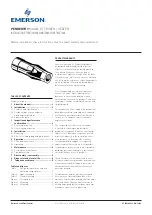
8
EURODESK SX3242FX/SX2442FX User Manual
2.2.3 Stereo channel aux/FX send buses
Basically, the aux and FX buses on the stereo channels are the same as on the
mono channels. Since aux buses are always mono, the signal from a stereo
channel is first mixed to mono before it is routed to the aux bus.
2.2.4 Stereo channel fader and other control elements
(
22
)
Fig. 2.7: Channel fader, balance control, mute switch, etc.
(22)
The
BAL
(ANCE) control has the same function as the PAN control on
the mono channels. It determines the relative volume of the left and
right input signals before they are routed to the stereo main mix bus
(or to two subgroups).
All other control elements of the stereo channels work in the same ways as their
counterparts on the mono channels (faders, MUTE switches, etc.).
◊
Please note: When you route a stereo channel to the subgroups
using the SUB switches, please be sure to set the BAL control to
its mid position, so that the signal is sent to two subgroups and
remains stereo.
2.3 Stereo channels 21-24 (SX2442FX) or
29-32 (SX3242FX)
(
23
)
(
24
)
Fig. 2.8: Auxiliary stereo channels
Your EURODESK has two stereo channels with an aux send section
(23)
(AUX 1 and AUX 2) and one LEVEL control.
(24)
For these channels, the aux buses
are hard-wired to pre-fader and are therefore particularly useful for monitoring.
They have no routing switches and are always sent to the main mix. Like the
normal stereo channels they have two line-level inputs on ¼" TRS connectors
for the left and right channels, and a SOLO switch.
Similar to the CD/TAPE inputs (see
(49)
) the auxiliary stereo channels
can be connected to CD players, tape decks, etc., for example, to feed in
playback material.
2.4 Subgroups 1 - 4
(26)
(25)
(27)
Fig. 2.9: Subgroups 1 - 4
The EURODESK has 4 subgroups enabling you to create mono or stereo mixes
from multiple input signals. Subgroups are controlled from one (mono) or two
(stereo) subgroup faders. Additionally, it is possible to connect the subgroup
outputs as tape sends to a multi-track recorder.
(25)
The subgroup faders determine the volume of the subgroup signal at the
subgroup output
(28)
. Depending on the position of the routing switch
(27)
you can thus control the subgroup volume in the main mix.
(26)
The
SOLO
switch routes the subgroup signal to the solo bus (Solo In Place)
or PFL bus (Pre Fader Listen), so that you can monitor the subgroup signal
without affecting the main or sub output signals. The signal to be monitored
is taken either pre (PFL, mono) or post-subgroup fader (Solo, stereo),
depending on the position of theSOLO/PFL switch
(40)
). The SOLO LED
illuminates when the SOLO switch is pressed.
(27)
Use the routing switches for the subgroups to send the subgroup signal to
the main mix. You can route it to the left stereo side (=LEFT pressed), to the
right stereo side (=RIGHT pressed) or to both (=LEFT and RIGHT pressed).
For example, when you have created a stereo submix using subgroups
1 and 2, be sure to route group 1 to the left and group 2 to the right side
to maintain proper stereo positioning. If it is a mono submix with just one
subgroup, route it to the left and right sides of the main mix to make the
signal audible on both sides.
(28)
Fig. 2.10: Subgroup outputs 1 - 4
(28)
These four
SUBGROUP OUT
(puts) carry the signals of the individual
subgroups. For multi-tracking connect the outputs to the inputs of a
multi-track recorder (see chapter 4.1 “Studio set-up”).
Содержание Eurodesk SX2442FX
Страница 20: ...We Hear You ...






































